Homebrew Hex Wire Beam Antenna
I put together a homebrew wire beam based on the "hex" style. The excellent commercial version of this is available by it's inventor, Traffie Technology for those who don't want to go to the hassles of building.
Hex Parts
The antenna is made up of several parts:
Base - main plate which holds the spreaders and mast. It's also attached directly to the rotor.
Mast - center post which has brass bolts for feeding each bands elements, plus feedline between them
Spreaders - six fiberglass poles in a radial pattern that hold the wire elements
Wire - 20 pieces of wire, 4 for each band, or 2 driven and 2 reflective wires for each of 5 bands. The reflective and driven elements are in back-to-back W or M shapes
Rope - 5 rope pieces help hold the spreaders and wire in the hexagon shape.
Feedline - wire or coax used between each band's driven elements. There is also the usual coax feedline to the antenna from the shack.
Top view of the wire layout. This is looking down the top onto the mast, with driven elements on top (one side fed with the coax center, the other ground) while the bottom wires, the reflective element, are tied together in the center. The blue blocks represent attachment points on the spreaders (not shown, but they radiate from the center) where the wires bend.
These green lines show how the spreaders radiate from the center base plate to hold the wires:
The red lines below indicate the extra 5 ropes used to hold the spreaders in place:
Hex Spreaders
The six spreaders are made from fiberglass tubing purchased from Max-Gain Systems.
To avoid extra costs for shipping 8' poles, I paid Max-Gain to cut the tubes into 4' sections and made simple joints to link them together. Each spreader consists of three tubing sections. The bottom third of each spreader is 3/4" tubing, while the middle and outer sections are 1/2" tubing. The joints are two types - if one tube slides into another, it is a simple 1" tube section glued onto the smaller tube to prevent it from sliding too far together. If both tubes are the same size, the joint consists of a short section of larger tube overlapping both sections, plus another short piece as a block.
My spreaders evolved as I built the antenna. The first attempt used 1/4" solid rod for the outer spreader section, but that doesn't have enough strength to give the 20m wire enough tension. At that point, I already had built the base and clamps for 3/4" tubing, so I bought more 1/2" tubing to replace the 1/4" rod plus one additional 3/4" tube to make the joints. If I was going to do this again from the start, I would use 1/2", 3/4" and 1" tubes, with 4' sections of each.
The lower junction between the 3/4" tubing and 1/2" tubing was made by cutting a short 1" chunk from the 3/4" tube. This was pushed onto the 1/2" tube about 6" up from the end and glued in place with epoxy. This allows the smaller tube to slide into the larger one up to the block.
For the joint between the upper two 1/2" rods, I cut a short (about 8") section of 3/4" tubing and glued it 4" onto the middle tube. I glued another 1" block onto the outer tube so it would slide into the middle and stop. As things worked out, the 17m antenna wires ended up clamped right at the top of this junction.
Hex Rigging
There are 5 pieces of rope holding the spreaders in position. At the top, there is one long piece that extends from spreader tip to spreader tip through the mast. This goes between the two spreaders at the wire element ends - since there are no wires going from these spreaders directly to the mast, this rope helps bow it into the proper shape. It passes through the top of the mast in two small holes. I added a knot in the middle (inside the mast) so it can be pulled from one side and get tension without pulling the rope through.
Two ropes are used on both the driven and reflective element sides between the other two spreaders. These ropes help hold the two spreaders in place as the wires bent outwards tend to pull them apart. I have one at the tip above the 20m attachment, and the second just above the 15m wires:
Hex Base
The antenna base is built from 1/2" plywood with an additional layer of plywood added to the center for reinforcement. The main hex shape is 18" from one flat side across.
The mast is supported by three L brackets. Originally the brackets supported the center PVC mast directly, but I found my attachment points were a bit low, so I added a short section of wooden dowel (actually a closet rod) at the bottom. The brackets now screw into the wood, and the dowel extends about 6" up into the mast.
The bottom of the spreaders are pushed into short sections of 1" plastic tubing to help spread out the clamping forces. The four bolts going down through the center disk bolt directly onto the rotor.
The wood was painted with two coats of exterior latex, then once everything was assembled it was sprayed with a few coats of light blue. I added some bits of darker blue to break up the silhouette.
Hex Mast
The mast is made from 1 1/2" diameter PVC pipe (1 3/4" outer diameter). It has a cap on the top to keep rain and animals out.
I'll have to add the actual measurement, but if you use 45" total length you should be OK. That's the total of the measurements above plus 3" headroom.
That said, the bottom length between the base plate and the 10m could be a few inches higher to line up with the final place where the wires ended up on the spreaders.
Each bolt is brass with several nuts stacked on. There's the bolt, one nut tightened down against the PVC, another holding the wire lug on, then another for the feedline/coax. On the top 20m driven element, there's another nut for the coax feedline from the shack.
Mark the PVC and drill holes for the nuts. The single bolt for the reflective elements is in the center of the back, while the two for the driven elements are on the opposite side, seperated by 60 degrees of the circle. I fished the bolts into the holes from the inside by wrapping a piece of wire around the bolt and then looking down the tube as I tried to find the hole. It sounds harder than it really is.
These are the bottom three bands (10, 12 and 15 meters) driven elements as attached to the mast. The feedline hasn't been added yet.
Hex Wire Lengths
Each of the five bands has four wire pieces. Two are connected together and form the reflector, while two are used in the driven element connected from each side of the coax feed. Each wire was cut to length and soldered to a wire ring for attachment to the brass bolts on the mast.
These lengths are based on the work done by Holger, DL7IO. He has done a lot of experimental work and modeling on the design.
In the end, I had to add about 2" to the 12m lengths above. The others worked out fine and didn't need tweaking.
For the end spacing, I used the following measurements:
It was easiest to make these adjustments with the end attachments I built. At the spreader, a short (about 1") piece of plastic tubing was pushed over the fiberglass tubing. Around this went a hose clamp with two zip ties through it. The zip ties formed a small loop, which I tied some kevlar line to. The two ends of the kevlar line went out to the terminal blocks that held the wire and line together.
The terminal blocks were from Radio Shack. I didn't keep the packaging, but I think it's part number 274-679 described as "12-position, Euro-style terminal strip holds 10- to 22-gauge wire and is rated up to 30 amps". Cut them apart with heavy wire clippers or sheet metal shears.
The rope is Kevlar / Dacron mix from RadioWorks.
Feeding the Hex
Probably the most interesting work I did on this antenna was with the feedline between each band's wire elements.
I first tried a solid #14 wire with wire O connectors soldered at intervals along the wire. These were bent so that the wires ran about 1/2" apart down the mast. With this setup, SWR was fine on the band where the coax was attached, but on each band further away from the feedpoint, things got worse. The dips were not deep nor always at the proper frequency.
The classic method for feeding the different bands is to use a think, braided wire running vertically along the mast. I tried this next, using heavy braided copper wire normally sold as heavy duty speaker cable. Again, things did not work out well. I could get a 3 band antenna without much trouble, but adding the WARC bands would again affect the frequencies farthest from the feed point.
After dwelling on this for a while and reading some discussions on the online Yahoo Hex Group, I decided to try coax cable. The feed between bands is supposed to be low impedance and low loss, and the RG-213 I had seems to fit that requirement.
I built a jig from wood and nails to match the brass bolts on the mast, then constructed short coax sections between them. I first did this for a 3 band version, and encouraged by the results, made a set for all 5 bands. The results were great. I got good, clean SWR curves on all bands, even 10m when the feedline attaches at the 20m top.
This is what the 4 jumpers look like. They have connector rings soldered on, and have recieved a few coats of rubber liquid sealer ("liquid tape") for weatherproofing. They later got a few coats of spray paint as well.
The main feedline attaches at the top wires (20m driven element) then is guided to the back (reflective element side) of the mast and runs down to the base. The balun winding ends up a few feet below the rotor, where there's an SO-239 connector for the main coax run.

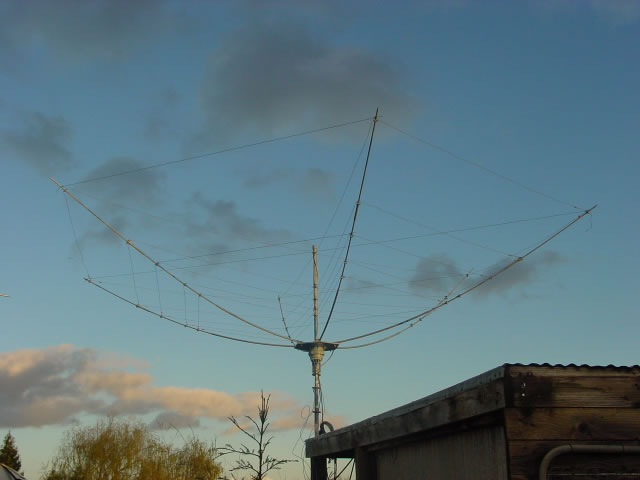
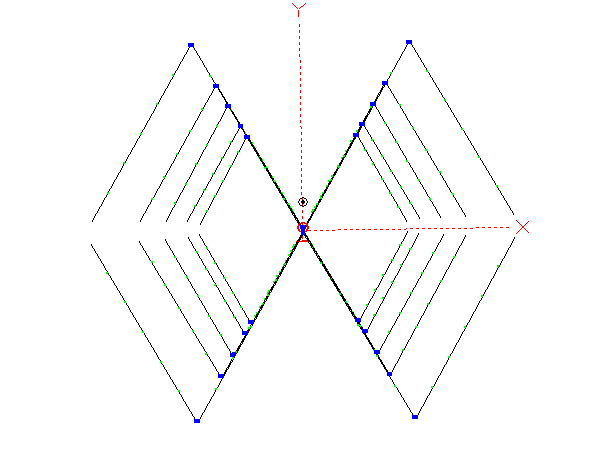
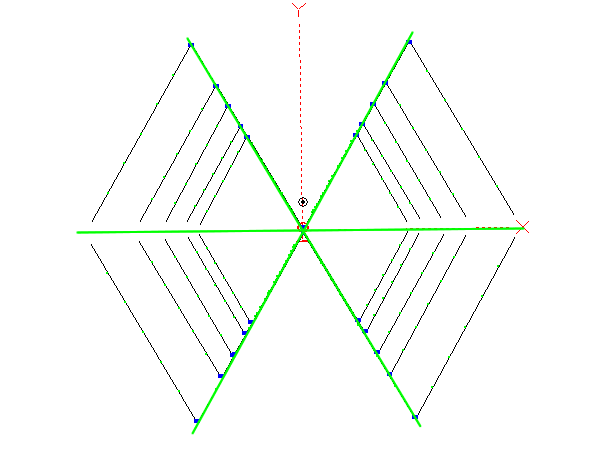
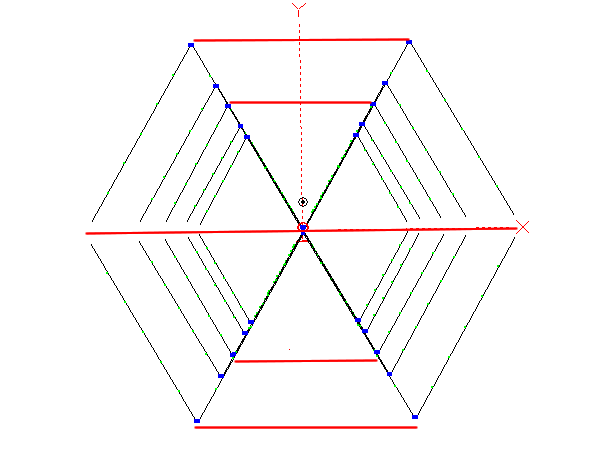
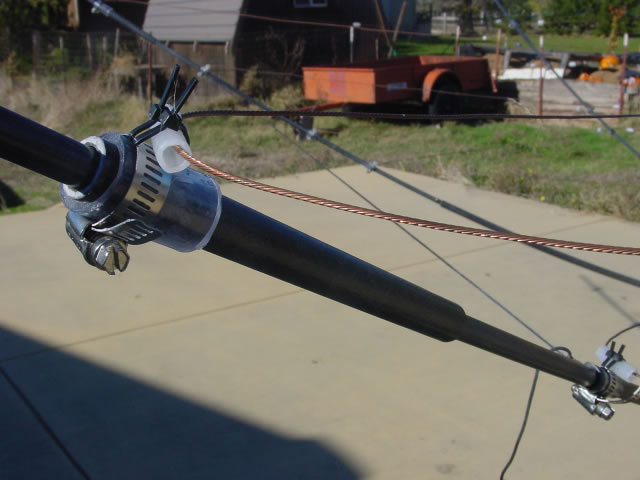

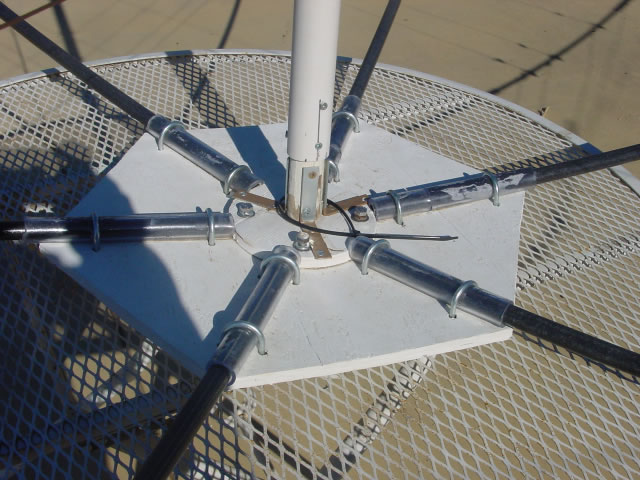

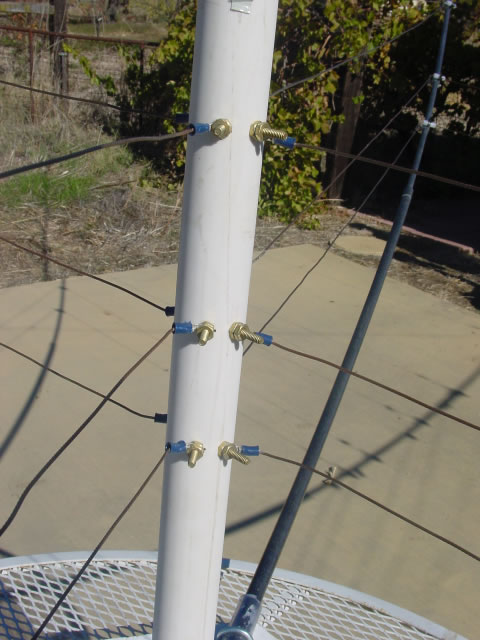


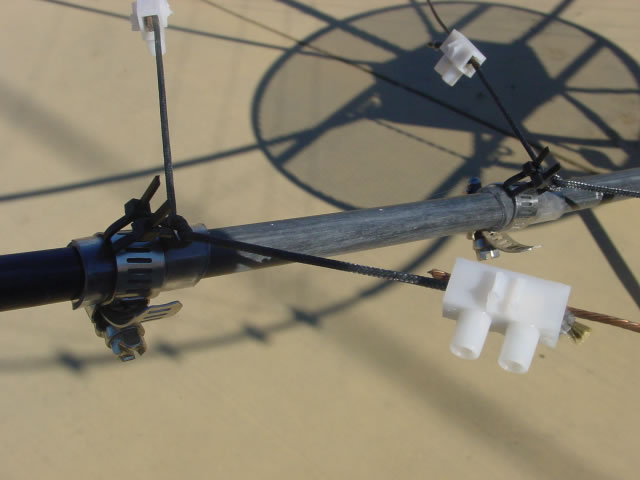
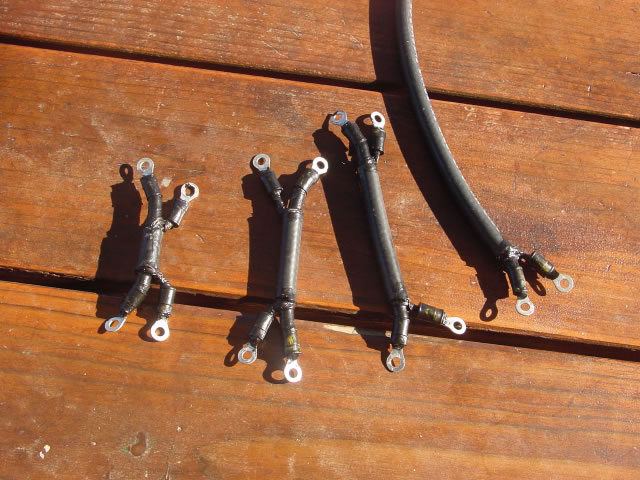

No comments:
Post a Comment